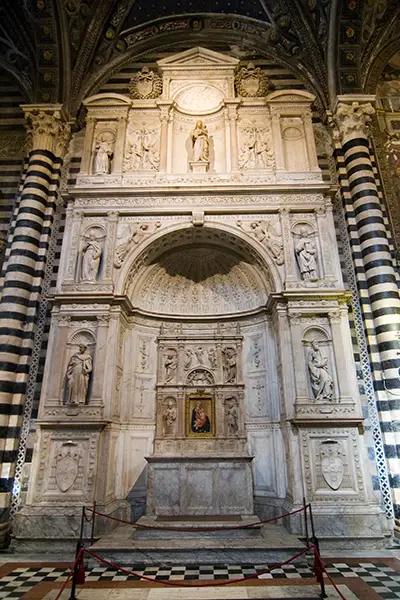The overall project sits in the left nave of this historic building which continues to attract large numbers of visitors every year within this culturally significant Italian city. It was cardinal Francesco Todeschini Piccolomini who initiated the project, with the intention of it becoming a tomb to house his own body in later years. As it turned out, he would later become Pope which ensured he would actually be buried in Vatican City, making this preparation unnecessary. That said, there is still much to appreciate about the work that was completed here, even though elements of the original design were not completed. Michelangelo ensured a consistent look by overseeing closely the work of his assistants which was entirely typical for how he made use of other workers throughout his career. As more and more commissions arrived, it became clear to Michelangelo that he could not accomplish all of these projects by himself and so he had to allow the aid of others from time to time.
Artist Michelangelo would contribute four sculptures in total, namely St Peter, St Pius, St Gregory and St Paul. He took over after Andrea Bregno had completed the main body of the structure, leaving just the supporting figures for those who followed. Michelangelo decided against working on the final items having been distracted by other projects that he was working on at the time and so his contribution was capped at the four figurative pieces. It is intriguing to see such an eclectic collection of art across the altarpiece, with contributions also coming from Jacopo della Quercia and Paolo di Giovanni Fei. In all, the different paintings and sculptures featured within the Piccolomini Altarpiece came from a period of over a century, making it impressive as to how it all still fits together stylistically. It is not an unusual situation though, as during the Renaissance many projects would overrun and require new contributors to replace others who passed away or simply fell out of favour.
It was on June 19th, 1501 that Michelangelo would receive his contract to produce a series of sculptures after several previous sculptors had abandoned the project, some of whom for unknown reasons. The sculptor himself had risen to fame with his Pieta, and that success was starting to open doors right across Italy. Ultimately, others offers would come in too, such as his David, and they would offer far more interest to the sculptor, perhaps explaining why he would later abandon the altarpiece project before it was entirely complete. It is important to remember that for great artists such as this, it is not simply financial gain that motivates, with prestige often being far more significant once their own financial security had been established.


